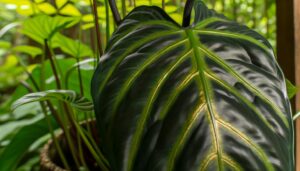What Soil Is Best for a Pink Princess Philodendron?
For best growth of a Pink Princess Philodendron, the soil should be a well-draining mix containing organic matter, aerating materials, and drainage-improving elements. Utilize components such as peat moss, perlite, and orchid bark.
Peat moss retains moisture and maintains slight acidity, while perlite and orchid bark improve soil aeration and drainage, preventing root rot. The soil pH should be between 5.5 and 6.5 to ensure nutrient availability.
This mix not only supports robust root development but also promotes vibrant foliage. Understanding these soil requirements can greatly enhance the health and importance of your Pink Princess Philodendron.
Explore further for better plant care practices.

Key Takeaways
- Use a mix of peat moss, perlite, orchid bark, and compost for balanced moisture retention and aeration.
- Ensure soil pH is between 5.5 and 6.5 for optimal nutrient absorption.
- Avoid garden soil; it lacks proper drainage and air circulation.
- Add perlite and orchid bark to improve soil drainage and prevent root rot.
- Consider store-bought options like Miracle-Gro Indoor Potting Mix or FoxFarm Ocean Forest Potting Soil.
Ideal Soil Composition
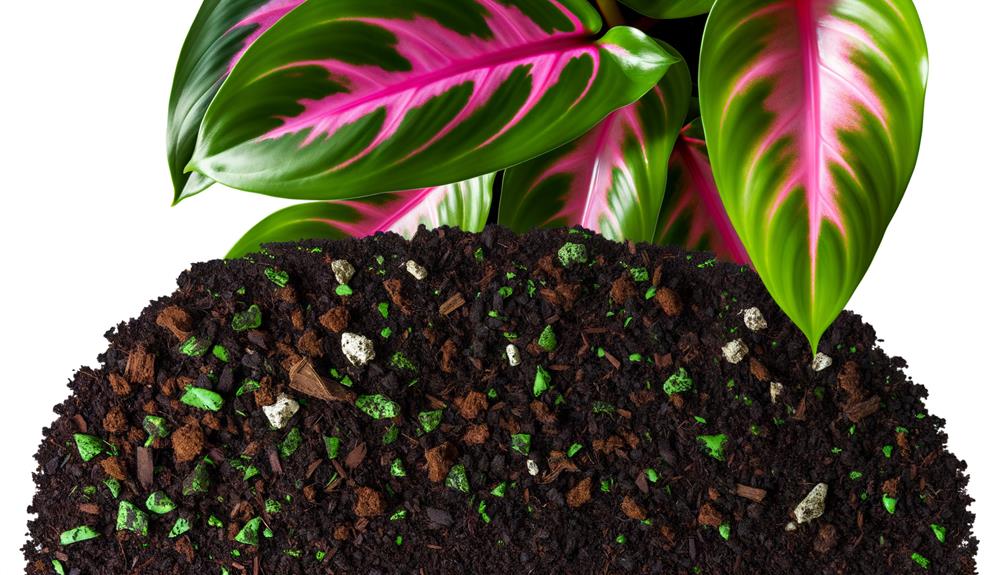
An ideal soil composition for a Pink Princess Philodendron should include a well-rounded mix of organic matter, aerating materials, and well-draining elements to support top growth and prevent root rot.
Organic matter, such as compost or peat moss, provides necessary nutrients and retains moisture.
Aerating materials like perlite or orchid bark enhance the soil's structure, ensuring sufficient oxygen reaches the roots.
Well-draining components, such as coarse sand or fine gravel, facilitate effective water movement, preventing waterlogging.
This well-balanced mixture promotes a strong root system, optimal for the plant's overall health and vibrant foliage.
Importance of Aeration
The importance of soil aeration in growing a Pink Princess Philodendron cannot be overstated.
Sufficient aeration guarantees the roots receive necessary oxygen, which is vital for cellular respiration and overall plant health.
Additionally, it reduces the chance of root rot and enhances nutrient absorption, promoting a robust and flourishing plant.
Roots Need Oxygen
Ensuring that the roots of a Pink Princess Philodendron receive adequate oxygen is necessary for preventing root rot and promoting overall plant health. Oxygen availability in the soil facilitates aerobic respiration, a crucial process for root cells to generate energy.
Without sufficient aeration, the roots can become deprived of oxygen, leading to diminished nutrient uptake and stunted growth. Best soil composition combines organic matter, such as peat or coco coir, with inorganic components like perlite or orchid bark to create air pockets. These air pockets improve soil structure and drainage, allowing oxygen to penetrate the root zone.
Regularly checking soil moisture levels and avoiding compaction are also important measures to maintain aeration and support the plant's vigorous growth.
Prevents Root Rot
Proper soil aeration is essential for preventing root rot in a Pink Princess Philodendron by ensuring excess water drains efficiently and roots remain oxygenated. Root rot occurs when the soil retains excessive moisture, creating anaerobic conditions that promote pathogenic fungi.
A well-aerated soil mix, typically incorporating elements such as perlite, orchid bark, and coarse sand, facilitates ideal drainage and air circulation. This prevents water from stagnating around the roots, thereby reducing the risk of rot.
Additionally, well-aerated soil allows roots to access the oxygen necessary for cellular respiration and overall plant health. Ensuring proper aeration in the soil mix is a critical step in maintaining a robust and thriving Pink Princess Philodendron, safeguarding it from the detrimental effects of root rot.
Enhances Nutrient Uptake
Best soil aeration greatly enhances nutrient uptake in a Pink Princess Philodendron by ensuring that roots have access to both essential minerals and the oxygen required for effective absorption processes.
Well-aerated soil facilitates the exchange of gases within the root zone, thereby preventing hypoxic conditions that can impair nutrient assimilation. This is achieved through the inclusion of porous materials such as perlite, orchid bark, and coarse sand, which maintain soil structure and promote air flow.
The presence of oxygen is crucial for root respiration, a process that drives the uptake of essential nutrients like nitrogen, phosphorus, and potassium. Consequently, optimizing soil aeration not only supports plant health but also maximizes growth and vibrant foliage, crucial for the Pink Princess Philodendron's ornamental appeal.
Proper Drainage Essentials
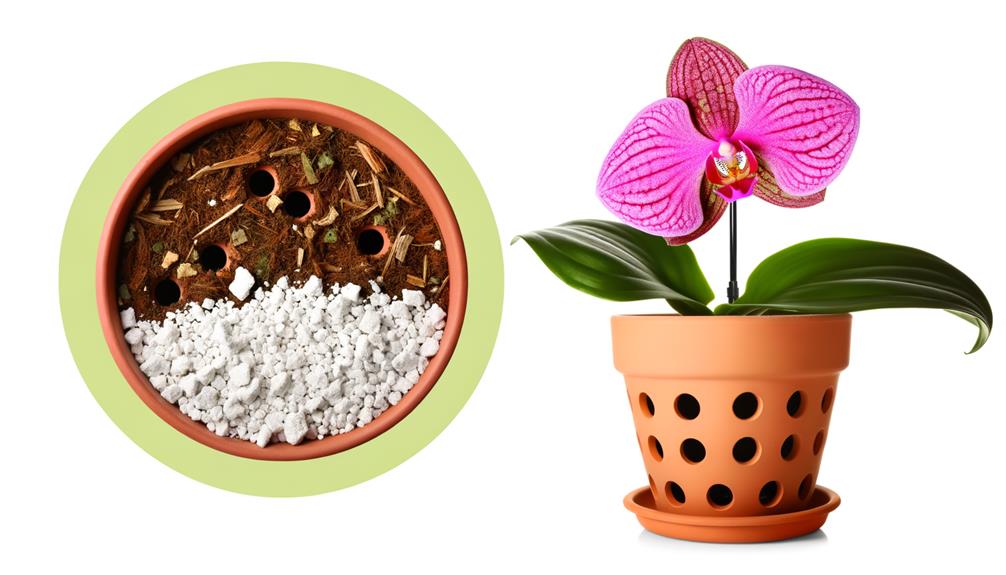
Achieving optimal drainage is crucial for the health of a Pink Princess Philodendron, as it helps prevent water stagnation and root rot, safeguarding the plant's longevity and vibrancy. Proper drainage involves choosing a well-ventilated soil mix that allows excess water to escape. A balanced combination of perlite, orchid bark, and peat moss enhances drainage efficiency.
| Component | Function | Proportion (%) |
|---|---|---|
| Perlite | Improves aeration | 30 |
| Orchid Bark | Enhances structure | 40 |
| Peat Moss | Maintains adequate moisture | 30 |
| Pumice | Additional drainage support | Optional |
| Sand | Extra drainage choice | Optional |
Customizing the soil mix to include these elements guarantees the roots stay healthy, preventing common issues like fungal infections and encouraging vigorous growth.
Organic Matter Benefits
Incorporating organic matter into the soil mix greatly enhances the nutrient profile and microbial activity, which are essential for the robust growth of a Pink Princess Philodendron. Organic matter, such as compost, decomposed leaf litter, or well-rotted manure, provides a steady release of nutrients that support foliage development and root health.
This enrichment fosters beneficial microbial colonies that improve soil structure, increase aeration, and enhance water retention. These factors collectively create an ideal environment for nutrient uptake. Additionally, organic matter improves cation exchange capacity, allowing the soil to hold and supply essential nutrients more effectively.
Ph Levels for Growth

The best pH range for a Pink Princess Philodendron is between 5.5 and 6.5, which promotes proper nutrient availability and uptake.
Maintaining this balance may require adjusting soil acidity through the use of additives such as lime or sulfur.
Understanding and managing pH levels is crucial for fostering healthy growth and vibrant foliage in this unique plant.
Optimal Ph Range
Understanding the most suitable pH range for a Pink Princess Philodendron is essential for ensuring strong growth and vibrant foliage. The ideal pH range for this tropical plant lies between 5.5 and 6.5, which is slightly acidic.
This range allows for the best absorption of essential nutrients such as nitrogen, phosphorus, and potassium, which are critical for the plant's health and coloration. Soil that is too acidic or too alkaline can hinder nutrient uptake, leading to deficiencies and poor growth.
Regularly testing the soil pH can help maintain this balance, ensuring the Pink Princess Philodendron thrives. Maintaining the correct pH is a fundamental aspect of cultivating a robust and visually striking specimen.
Adjusting Soil Acidity
Maintaining the best pH range for a Pink Princess Philodendron may occasionally require adjusting soil acidity to secure nutrient absorption and overall plant health. Ideally, the soil pH should be between 5.5 and 6.5.
If the pH is too high, sulfur or aluminum sulfate can be incorporated to lower it. Conversely, if the pH is too low, lime or dolomitic limestone can be added to elevate it. Regularly testing the soil pH is vital for timely adjustments.
Additionally, organic matter such as peat moss can help buffer pH fluctuations. These adjustments secure that essential nutrients remain available, fostering strong growth and vibrant foliage in your Pink Princess Philodendron.
Choosing Soil Amendments
Selecting appropriate soil amendments is essential for optimizing the growth and health of your Pink Princess Philodendron. These amendments enhance soil structure, aeration, and nutrient availability.
Consider incorporating the following:
- Perlite: Enhances aeration and drainage, preventing root rot.
- Coco coir: Retains moisture while providing excellent drainage and aeration, mimicking natural tropical conditions.
- Worm castings: Rich in essential nutrients and beneficial microorganisms, promoting robust plant growth.
- Activated charcoal: Improves soil aeration and acts as a natural detoxifier, removing impurities and excess moisture.
Analyzing your soil's current composition and integrating these amendments can greatly improve its suitability for your Pink Princess Philodendron, fostering a thriving, healthy plant.
Mixing Your Own Soil
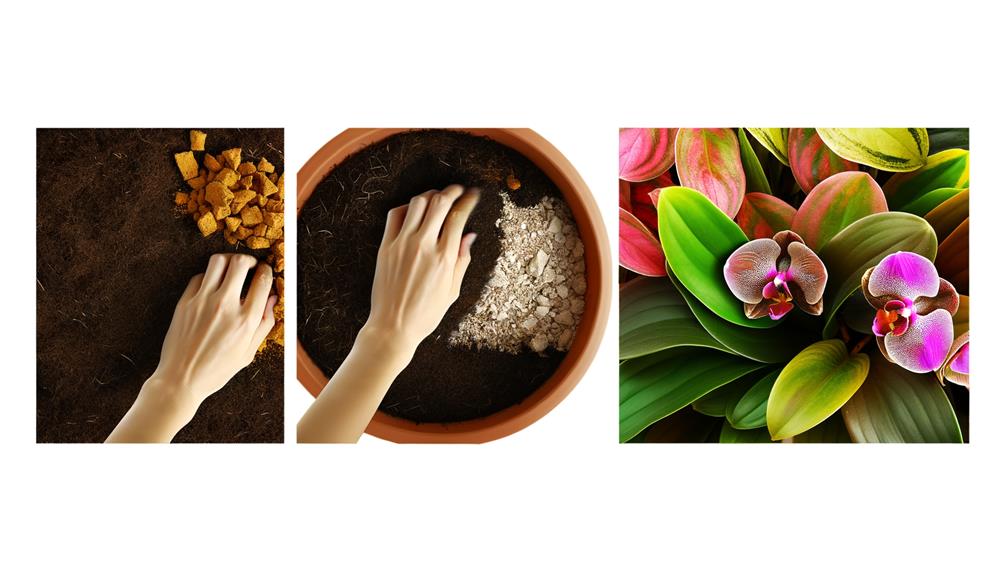
Creating a custom soil mix tailored for your Pink Princess Philodendron involves combining specific components to achieve ideal drainage, aeration, and nutrient availability. The primary ingredients typically include peat moss, perlite, orchid bark, and compost. Each component serves a unique purpose in fostering a healthy root environment.
| Component | Purpose |
|---|---|
| Peat Moss | Retains moisture and provides acidity |
| Perlite | Enhances drainage and aeration |
| Orchid Bark | Promotes air circulation around roots |
| Compost | Adds organic nutrients |
For best results, blend these components in the following ratios: 40% peat moss, 20% perlite, 20% orchid bark, and 20% compost. This balanced mix ensures that your Pink Princess Philodendron receives adequate moisture while preventing root rot and promoting robust growth.
Store-Bought Soil Options
While crafting a custom soil mix can be highly advantageous, there are also several high-quality store-bought soil options specifically formulated to support the unique needs of a Pink Princess Philodendron. These options offer a balanced mix of essential nutrients and organic matter, ensuring optimal growth and well-being.
Here are four notable store-bought soil options:
- Miracle-Gro Indoor Potting Mix: This mix provides excellent aeration and contains essential nutrients, promoting healthy root development.
- FoxFarm Ocean Forest Potting Soil: Rich in organic material, this soil ensures robust growth and vitality.
- Espoma Organic Potting Mix: Ideal for its balanced pH and nutrient profile, fostering a conducive growing environment.
- Black Gold All Purpose Potting Soil: Known for its superior moisture retention and drainage, supporting overall plant health.
Each option provides a reliable foundation for thriving Pink Princess Philodendrons.
Water Retention Needs
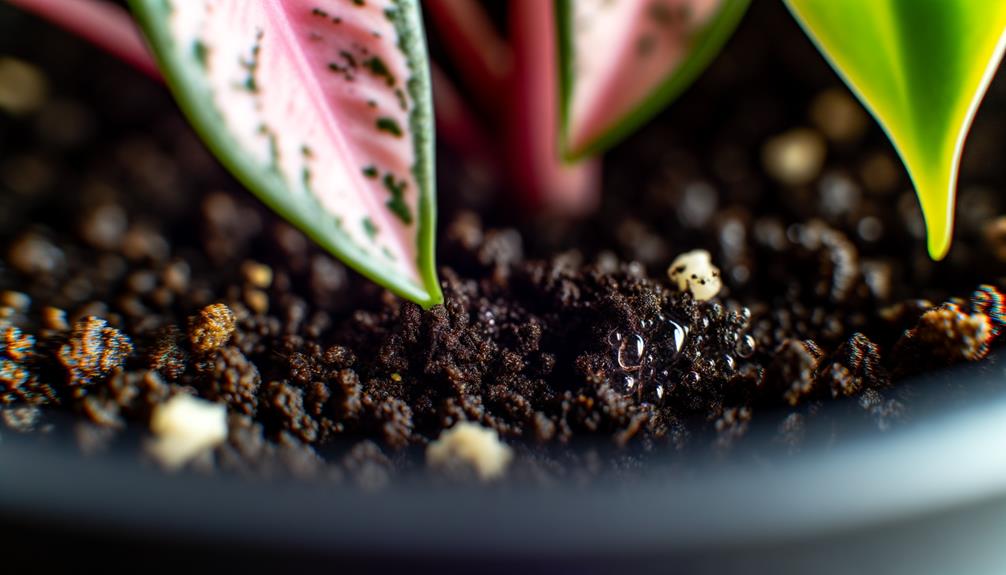
Understanding the water retention needs of a Pink Princess Philodendron is essential for maintaining ideal moisture levels while preventing root rot.
This plant thrives in soil that retains enough moisture to keep the roots hydrated yet drains well enough to avoid waterlogging.
Achieving this balance requires a detailed analysis of soil composition and its ability to regulate water appropriately.
Optimal Moisture Levels
Maintaining ideal moisture levels for a Pink Princess Philodendron is crucial, as this plant requires soil that strikes a balance between adequate water retention and proper drainage to prevent root rot. Best moisture levels can be managed by focusing on the following factors:
- Soil Composition: Utilize a mix of potting soil, perlite, and orchid bark to enhance drainage while retaining necessary moisture.
- Watering Frequency: Water the plant when the top inch of soil feels dry to the touch, avoiding over-saturation.
- Humidity: Maintain a humidity level between 60-80% to mimic the plant's natural tropical environment.
- Pot Selection: Choose pots with drainage holes to allow excess water to escape, further preventing waterlogged conditions.
These practices ensure the Pink Princess Philodendron thrives in its best moisture environment.
Preventing Root Rot
Preventing root rot in a Pink Princess Philodendron requires a thorough approach to managing water retention, making sure that the soil remains neither too wet nor too dry.
The key lies in selecting a well-draining potting mix, which typically includes components such as perlite, orchid bark, and peat moss. These elements create an airy structure, promoting sufficient drainage while retaining essential moisture. Additionally, incorporating a layer of activated charcoal can further help in preventing fungal growth.
Regularly monitoring the moisture level by checking soil dryness before watering is essential. Employing pots with drainage holes will facilitate excess water escape, thereby reducing the risk of root rot. This balanced approach guarantees the philodendron's roots remain healthy and robust.
Common Soil Mistakes
A prevalent mistake when selecting soil for a Pink Princess Philodendron is opting for a mixture that retains excessive moisture, leading to root rot and other health issues for the plant. To ensure ideal growth, avoid the following common errors:
- Using Garden Soil: Often too dense and compact, garden soil lacks the necessary air circulation and drainage.
- Ignoring Soil pH: A pH level outside the ideal range of 5.5 to 7 can inhibit nutrient absorption.
- Over-reliance on Peat Moss: While it retains moisture, excessive peat moss can suffocate roots without proper air circulation.
- Skipping Perlite or Bark: These components enhance soil drainage and prevent waterlogged conditions.
Understanding these pitfalls guarantees a healthier environment for your Pink Princess Philodendron.
Conclusion
To sum up, the best soil for the Pink Princess Philodendron must balance aeration, drainage, and organic matter, with an ideal pH of 5.5 to 7.0. According to horticultural studies, soils with 30-40% organic matter greatly enhance plant health and growth. Proper soil composition is essential for preventing root rot and ensuring sufficient water retention.
Whether mixing soil at home or choosing store-bought options, grasping these basic requirements is vital for nurturing a flourishing Pink Princess Philodendron.






